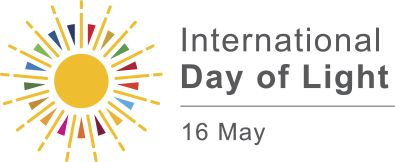IS THE 16TH OF MAY THE DAY WITH THE MOST LIGHT OF THE YEAR?
No, we know that not, it happens when the summer solstice of each hemisphere takes place and the sun reaches its maximum height at noon; then corresponds to the longest day of the year. But, why do we ask this question? It has his trap.
It is the International Day of Light … and its applications in multiple fields: science, optics, culture and daily life.
And Astronomy is light – the measures based on its speed in the universe, as radiation that makes life possible, as a marker of biological cycles and in the capture through telescopes and photographic objectives – we have to do echo your commemoration and share with you all the information that UNESCO facilitates for your follow-up: www.lightday.org

The major goals of the International Day of Light are:
Improve the public understanding of how light and light-based technologies touch the daily lives of everybody, and are central to the future development of the global society.
Build worldwide educational capacity through activities targeted on science for young people, addressing issues of gender balance, and focusing especially on developing countries and emerging economies.
Highlight and explain the intimate link between light and art and culture, enhancing the role of optical technology to preserve cultural heritage.
Enhance international cooperation by acting as a central information resource for activities coordinated by learned societies, NGOs, government agencies, educational establishments, industry, and other partners.
Emphasise the importance of basic research in the fundamental science of light, the need for investment in light-based technology to develop new applications, and the global necessity to promote careers in science and engineering in these fields.
Promote the importance of lighting technology and the need for access to light and energy infrastructure in sustainable development, and for improving quality of life in the developing world.
Raise awareness that technologies and design can play an important role in the achievement of greater energy efficiency, in particular by limiting energy waste, and in the reduction of light pollution, which is key to the preservation of dark skies.
Another version, more corporate, is the interpretation that we give to the light as a metaphor and that originates the name of this blog: the light that brings the knowledge obtained through science. Hence “luminisc (i) ence”.
The luminescence is a type of light emission with its own characteristics that does not even depend on the temperature, which is the difference of the incandescence (see+info), but that we have chosen as an idea that merges the contributions of the Enlightenment -with more inclusive principles in gender and social stratum- with the energy saving that so characterizes us. Look if not our #bestarfriendly astrot-shirt, which is based precisely on luminescent inks, in this case especially chosen for their lower environmental impact (they are free of phthalates, nonylphenols and heavy metals), and that allows a certain illumination in the dark in line with the fight against light pollution to transmit a holistic message of ecology and science.
Everything is connected in the Astrotouristing universe. Everything is based on evidence, sustainability, and also a humanistic and social positioning that gives rise to the set of guidelines and actions that sustains ourMANIFESTO.
The astrotouristers are at the forefront …
Resources: MATERIA (El País), International Day of Light – UNESCO, EcuRed.